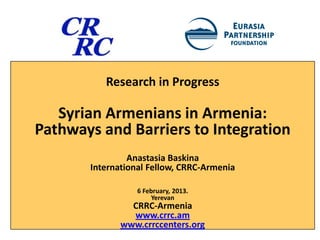Syrian Armenians in Armenia: Pathways and Barriers to Integration
- 1. Research in Progress Syrian Armenians in Armenia: Pathways and Barriers to Integration Anastasia Baskina International Fellow, CRRC-Armenia 6 February, 2013. Yerevan CRRC-Armenia www.crrc.am www.crrccenters.org
- 2. Presentation Structure 1. Research objectives and methodology 2. Background information and basic facts 3. Legal status of Syrian Armenians in Armenia 4. Major barriers to integration 5. Key stakeholders and their response 6. Assessement of stakeholdersŌĆś actions 7. Q & A and Discussion
- 3. 1. Research objectives and methodology Research objectives: ŌĆó To identify major barriers to integration of Syrian Armenians in Armenia ŌĆó To examine measures undertaken by the government, civil society and international organizations to address the issue Methodology: ŌĆó 10 Expert interviews (MoD, Coordination Center, State Migration Service, Mission Armenia, Red Cross, RepatArmenia, Cilicean school, ŌĆ”) ŌĆó 9 Interviews with representatives of SA Diaspora in Armenia Limitations: No official statistics available, difficult or impossible to verify numbers and facts
- 4. 2. Background information ŌĆó Armenian Diaspora in Syria before the war: 60.000-80.000 people ŌĆó Concentrated mainly in Aleppo; middle-class ŌĆó Civil war in Syria since March 2011 ŌĆó Thousands SA left for Armenia, Lebanon, the Persian Gulf states, Europe ŌĆó Aleppo-Yerevan flights are currently suspended. Latakia-Yerevan flight instead, 10-12 hours by bus to Latakia from Aleppo ŌĆó 6000-7000 Syrian Armenians in Armenia because of the conflict; though the real figure could be lower - 4000-5000 ŌĆó Only about 10% register with the State Migration Service ŌĆó 90% stay in Yerevan
- 5. 3. Legal status ŌĆó Options: ŌĆō Armenian passport ŌĆō Residence permit (1, 5, 10 years) ŌĆō Visa ŌĆó Very few apply for refugee status (580 as of mid-January) ŌĆō Refugees de facto but not de jure
- 6. 4. Major barriers to integration ŌĆó Housing (lack of social housing) ŌĆó Unemployment and low salaries (most work outside of their field) ŌĆó Food ŌĆó Winter clothing, shoes ŌĆó Household items, furniture, etc. ŌĆó Language ŌĆó False expectations
- 7. 5. Key stakeholders ŌĆó Governmental actors: Ministry of Diaspora, M. of Economics, M. of Health, M. of Education and Science, National Center for SME, ŌĆ” ŌĆó International organizations, UN, NGOs, Diaspora and ecumenical organizations, foreign governments: Center for Coordination of Syrian ArmeniansŌĆÖ Issues, AGBU, ARF, Hayastan All Armenian Fund, Cilicia charitable organization, RepatArmenia, Armenia Inter-Church Charitable Round Table Foundation, UNHCR, UNICEF, Armenian Red Cross Society, Mission Armenia, Saved Relics, Kuwait, ŌĆ”
- 8. 5.1. Governmental response ŌĆó Applications for Armenian citizenship from Syria ŌĆó Visa at the border ŌĆó Exemption from visa and residence permit fees ŌĆó Free health care ŌĆó University tuition fees ŌĆó Syrian driving licenses ŌĆó Orientation classes for prospective businessmen ŌĆó Start-up loans up to USD 12.000 with 5% interest rate ŌĆó Job fairs, consultations
- 9. 5.2. Non-governmental response ŌĆó Center for Coordination of SA issues ŌĆō coordination, aid distribution ŌĆó AGBU ŌĆō housing subsidies (AMD 40.000-60.000) ŌĆó Armenia Inter-Church Charitable Round Table ŌĆō food coupons to 200 families ŌĆó Armenia Relief Society ŌĆō ŌĆ£Help your brother initiativeŌĆØ ŌĆó UNHCR (through Red Cross and Mission Armenia) - coupons for winter clothing, shoes; furniture, household items, medical care ŌĆó Cilicia charityŌĆō Syrian Armenian school in Yerevan (around 310 kids) ŌĆó Hayastan All-Armenian Fund ŌĆó RepatArmenia ŌĆō Syrian Armenian Market Project ŌĆó Kuwait ŌĆō USD 100.000 - food coupons for 1000 families
- 10. 6. Assessment of stakeholdersŌĆÖ actions ŌĆó Lack of centralized information and communication between all parties involved - > word of mouth, rumors ŌĆó Delayed response (housing!) ŌĆó Limited resources creating structural barriers ŌĆó Passive approach to fundraising ŌĆó Government focus on business leaders so far ŌĆó Hard to make needs assessment ŌĆō fair aid distribution?
- 11. Questions? ;)
- 12. Thank you! ’üŖ www.crrc.am www.crrccenters.org











